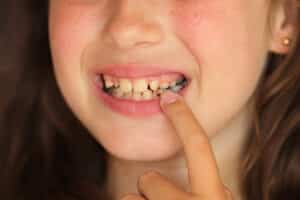An amazing smile doesn’t start with the first set of braces. It starts with knowing the importance of orthodontic care. Despite this, a lot of parents have trouble deciding, “When should my child see an orthodontist?” especially since there are a lot of myths and different pieces of advice out there.
This blog aims to clear the fog surrounding this topic, providing clear, actionable insights into orthodontic care for children. We want to give you the information you need to make smart choices about your child’s oral health by taking the mystery out of the process.
Understanding Orthodontic Care

Orthodontics is the branch of dentistry that ensures proper function and aesthetics, contributing significantly to overall oral health. While orthodontists and dentists both play vital roles in maintaining oral health, an orthodontist undergoes additional years of specialized training focused on correcting bites, straightness of teeth, and jaw alignment.
Children may face various orthodontic issues, such as crowding, spacing, overbite, and underbite. These conditions not only affect the appearance of their smile but can also impact their ability to chew, speak, and maintain oral hygiene. Recognizing these issues early on can be crucial in deciding the timing and course of orthodontic treatment, potentially preventing more complex problems later in life.
Signs Your Child Might Need Orthodontic Evaluation
Identifying the need for an orthodontic evaluation in a child is the first step toward a lifetime of healthy smiles. While only an orthodontist can determine the necessity for treatment, several indicators may suggest a visit is in order.
When should my child see an orthodontist? If your child exhibits any of the following signs, it might be time to schedule an evaluation:
- Misaligned Teeth or Bite: One of the most visible signs, misalignment includes overbites, underbites, crossbites, and open bites. These issues can affect how your child eats, speaks, and smiles.
- Difficulty in Chewing or Biting: If your child struggles or expresses discomfort during eating, it could signal misalignment or bite issues that orthodontic care can address.
- Early or Late Loss of Baby Teeth: The timing of tooth loss can impact the alignment of permanent teeth. Either premature or delayed shedding of baby teeth warrants a professional assessment to avoid potential complications.
- Mouth Breathing: Consistent mouth breathing can indicate the presence of obstructions in the nasal passage or issues with jaw development, both of which can affect facial growth and tooth alignment.
- Speech Impediments: While not always linked to orthodontic issues, certain speech difficulties can stem from misaligned teeth or jaw problems, impacting your child’s clarity of speech.
- Crowded Front Teeth After Age Seven: Crowding can become apparent once the permanent front teeth start to come in. Addressing this early can prevent more severe crowding and misalignment as more teeth emerge.
Is treatment always necessary?
Observing any of these signs in your child does not automatically mean they will need braces or immediate orthodontic treatment. However, they do signify that an evaluation by a specialist is advisable to assess whether there are underlying issues that might benefit from early intervention. An orthodontic check-up can provide peace of mind or a timely strategy for ensuring your child’s oral health is on the right track.
When Should My Child See an Orthodontist? The Best Age for their First Orthodontic Visit

A question that often puzzles parents is: when should my child see an orthodontist?
The American Association of Orthodontists recommends that children have their first check-up with an orthodontist no later than age 7. While this may seem young, early evaluation allows orthodontists to identify potential issues with jaw growth and emerging teeth while some baby teeth are still present.
This early assessment doesn’t always lead to immediate treatment. Instead, it provides a unique opportunity for preventative measures that can guide the growth of the jaw and the development of teeth. In some cases, early intervention can significantly reduce the complexity of future treatment or even make further treatment unnecessary.
Orthodontists use this initial visit to monitor a child’s development over time. They can spot subtle problems with jaw growth and emerging teeth while some baby teeth are still in place. This proactive approach is known as interceptive orthodontics, which can involve guiding the growth of the jaw, correcting harmful oral habits, and making space for permanent teeth to properly emerge.
What Happens During the First Visit?
The first orthodontic visit is a crucial step towards understanding the current state and future needs of your child’s oral health. This initial consultation is designed to be informative and reassuring for both parents and children, laying the groundwork for any potential treatment. Here’s what typically happens during this visit:
- Comprehensive Examination: The orthodontist will perform a thorough examination of your child’s teeth, jaw, and bite, looking for signs of potential problems. This examination might include observing how your child bites down, checking for overcrowding or misalignments, and examining the jaw’s position.
- Diagnostic Records: Depending on the findings from the initial examination, the orthodontist may take diagnostic records such as X-rays, photographs of the face and teeth, and digital scans. These records are crucial for developing a precise treatment plan, as they provide a detailed view of both the visible and underlying structure of the teeth and jaw.
- Discussion of Findings: After the examination and any necessary diagnostic tests, the orthodontist will discuss their findings with you. This conversation will cover whether treatment is recommended, the objectives of the proposed treatment, and whether any immediate action is needed or if it’s better to wait and monitor your child’s growth and development further.
- Treatment Options: If treatment is advised, the orthodontist will outline the possible options and recommendations, including the types of orthodontic devices that might be used, such as braces or aligners. They will also provide an estimated timeline for how long the treatment might take.
- Financial Information and Planning: Finally, the orthodontist’s office will provide information about the cost of the proposed treatment, payment options, and insurance coverage, if applicable. This is also a good time to ask any questions you might have about the financial aspects of treatment.
Benefits of Early Orthodontic Evaluation

When should my child see an orthodontist and why? Early orthodontic evaluation provides a foundation for children’s dental health that can have long-lasting benefits. Understanding the advantages of having your child assessed by an orthodontist at a young age is crucial for making informed decisions about their oral health care. Here are several key benefits:
Prevention of Complex Problems
Early detection of orthodontic issues allows for interventions that can prevent more serious problems down the line. Interceptive treatment can address issues such as crowding, misalignments, and bite problems before they become more complex and harder to correct.
Reduced Treatment Time
When orthodontic issues are identified and treated early, the overall time required for treatment can often be significantly reduced. This is because the jaw is still growing, making it easier to address certain conditions, such as misaligned jaws or overcrowded teeth.
Improved Oral Health
Early orthodontic evaluations can lead to treatments that improve oral health. Properly aligned teeth are easier to clean, reducing the risk of decay and gum disease. Additionally, correcting bite problems can prevent difficulties with eating, speaking, and even breathing, contributing to overall well-being.
Guidance of Jaw Growth
Orthodontists can influence the direction of jaw growth in a growing child, which can help prevent discrepancies in jaw alignment. This proactive approach can minimize the need for more invasive treatments later, such as jaw surgery.
Self-Esteem and Confidence
A healthy, straight smile can boost a child’s self-esteem and confidence. Early treatment can ensure that children don’t have to feel self-conscious about their teeth during their critical development years.
Cost Savings
While it might seem counterintuitive, investing in early orthodontic evaluation and, if necessary, treatment can result in cost savings over time. Preventing more severe problems from developing can reduce the need for more extensive and expensive treatment in the future.
Customized Treatment Planning
Early evaluation gives orthodontists the ability to create a tailored treatment plan that grows with your child. Monitoring the development of the teeth and jaw over time allows for adjustments to be made as needed, ensuring optimal results.
Secure Your Child’s Smile with Belleville Pediatric Dentistry
At Belleville Pediatric Dentistry, we understand that the foundation for a lifetime of radiant smiles starts with the care given today. Our clinic in Belleville, NJ, offers a warm, child-friendly environment that prioritizes the dental health and comfort of your young ones. With a team of talented and highly qualified dentists, we specialize in transforming dental care into a positive experience for both children and parents.
Why Belleville Pediatric Dentistry?
- Expertise in Pediatric Care: Our dentists are not just experts in dentistry; they are experts in making dental care comfortable and enjoyable for children. With specialized training in pediatric dentistry, we excel in treating the unique needs of young smiles.
- Focus on Proactive Prevention: We believe in the power of prevention. Our approach includes educating both parents and children on effective oral hygiene practices, ensuring healthy habits that last a lifetime. By focusing on preventive care, we help keep minor issues from becoming major ones.
- Comprehensive Oral Health and Development: From the first tooth to braces and beyond, our comprehensive pediatric dentistry and orthodontic services guide your child’s dental development every step of the way. We’re more than just a dental practice; we’re a partner in your child’s oral health journey.
- A Truly Kid-Friendly Environment: We’ve designed our office with your child’s happiness and comfort in mind. From engaging activities to a welcoming atmosphere, every aspect of Belleville Pediatric Dentistry is meant to make dental visits enjoyable and stress-free.
Take the First Step Towards a Lifetime of Beautiful Smiles
Let us be your partner in ensuring your child’s smile flourishes. Schedule a visit to Belleville Pediatric Dentistry today and experience the difference expert, child-centric dental care can make. Your child’s journey to a lifetime of beautiful smiles starts here.

